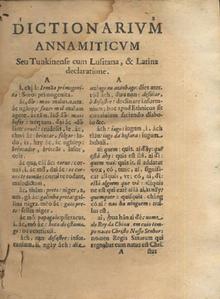

The Dictionarium Annamiticum Lusitanum et Latinum (known in Vietnamese as Tự điển Việt-Bồ-La) is a trilingual Vietnamese-Portuguese-Latin dictionary written by the French Jesuit lexicographer Alexandre de Rhodes after 12 years in Vietnam. It was published by the Propaganda Fide in Rome in 1651, upon Rhodes's visit to Europe, along with his catechism Phép giảng tám ngày.
Background
Before Rhodes's work, traditional Vietnamese dictionaries showed the correspondences between Chinese characters and Vietnamese chữ Nôm script. From the 17th century, Western missionaries started to devise a romanization system that represented the Vietnamese language to facilitate the propagation of the Christian faith, which culminated in the Dictionarium Annamiticum Lusitanum et Latinum of Alexandre de Rhodes.

Dictionarium Annamiticum Lusitanum et Latinum was itself inspired by two earlier lost works: a Vietnamese–Portuguese dictionary by Gaspar do Amaral [Wikidata] and a Portuguese–Vietnamese dictionary by António Barbosa.
Content
The dictionary has 8,000 Vietnamese entries with glosses in Portuguese and Latin. The publication also incorporates a summary on Vietnamese grammar (Linguae Annamiticae seu Tunchinensis Brevis Declaratio) and the codification of some contemporary pronunciations.
Impact
The dictionary established chữ Quốc ngữ, the Vietnamese alphabet, which was refined by later missionaries and eventually became the predominant writing system for Vietnamese. Mgr Pigneau de Béhaine contributed to these improvements with his 1783 Annamite–Latin dictionary, the manuscript of which was remitted to Mgr Jean-Louis Taberd who published in 1838 his Vietnamese–Latin / Latin–Vietnamese dictionary.
Despite those efforts, Christian publications in Vietnam continued to use either Latin or the traditional Vietnamese chữ Nôm, rather than the simpler alphabetic Quốc ngữ, for the next 200 years. Quốc ngữ gained only predominance after the French invasion of 1858 and the establishment of French protectorate.
See also
Notes
- ^ Wörterbücher: Ein Internationales Handbuch Zur Lexikographie by Franz Josef Hausmann, p.2583
- Researches Into the Physical History of Mankind By James Cowles p.501
- ^ Wörterbücher: Ein Internationales Handbuch Zur Lexikographie by Franz Josef Hausmann, p.2584
- A Vietnamese Reference Grammar by Laurence C. Thompson p.54
- Vietnamese tradition on trial, 1920–1945 By David G. Marr, p.145
References
- Gaudio, Andrew (2019). "A Translation of the Linguae Annamiticae seu Tunchinensis brevis declaratio: The First Grammar of Quốc Ngữ". Journal of Vietnamese Studies. 14 (3). University of California Press: 79–114. doi:10.1525/vs.2019.14.3.79. S2CID 202274343.